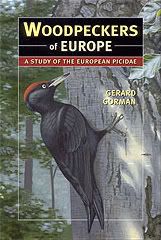Tuesday, 20 November 2007
Drumming
Drumming is a form of song, a method of communication that only woodpeckers produce. It is not, as is sometimes presumed, a foraging technique or part of nest hole excavation work. Though woodpeckers make noises on wood with their bills in other ways (when excavating holes and when feeding) this is not drumming. The sounds made by drumming are actually quite simple and though drumming replaces song (as we know it for passerines) it is less complicated. Nine out of ten of Europe’s woodpecker species drum in the true sense. Wrynecks sometimes appear to drum by their nest-holes, very lightly and probably to advertise the site to partner, or to confirm ownership, but this is rarely heard or observed. Wrynecks also occasionally tap at trees but this behaviour may be linked to foraging rather than to communication. Drumming is a very fast series of strikes done with the bill on a hard surface. The special anatomy of the skull facilitates this potentially dangerous behaviour. Muscles in the head and neck contract just before impact and in the process absorb the shock waves made by the drumming. Woodpeckers choose certain areas of a tree (or other surface) and drum there to announce or confirm their presence and claim to territory. They may also drum when alarmed or agitated. Woodpeckers have several favourite drumming posts in their breeding territories and regularly visit and use them in the pre-breeding period. Dry, dead snags and branches are most often used, probably because they resonate better. Drumming posts are always located high up, almost certainly because woodpeckers know that the sound will carry further. Drumming is, and must be, far carrying and this is achieved also by woodpeckers choosing drumming posts, such as hollow snags, that have good acoustic properties. This probably explains why artificial surfaces such as lamp-poles and satellite dishes are sometimes used. Drumming is rarely done on windy days, perhaps because birds have realised the futility of it. Drumming is seasonal and as it replaces song it is mainly, but not only, carried out in the pre-breeding period. It is reduced when pairs are formed. Drumming by male woodpeckers also attracts females and declares to other males that a territory is claimed and occupied. In the pre-courtship phase of breeding Black Woodpeckers, for example, a male will drum hundreds of times per day. Females probably drum in order to keep in contact with males and to reinforce the pair bond and declare territorial rights to other pairs. Some species, especially those with larger territories like White-backed and Black Woodpeckers, indulge in long-distance communication by drumming. Most species also indulge in some light drumming just after leaving or before entering the roost hole and this may be done all year round. Drumming is species specific. The number of beats per second, the cadence, and the rhythm of the phrase can be diagnostic. Other things to consider are duration, intensity, interval between strikes (speed) and changes in tempo. Some species, such as Great Spotted, drum in a rhythmic pattern; others such as Black Woodpecker produce strong, solid bursts. Lesser Spotted Woodpeckers produce more of a rattle than a drum. There is a relationship between the size of the woodpecker drumming and the volume of the drumming, however the volume and quality of any drumming is also dependent upon the surface and condition of the drumming post.
Subscribe to:
Post Comments (Atom)





1 comment:
supreme hoodie
supreme clothing
yeezy shoes
jordan shoes
off white outlet
Post a Comment